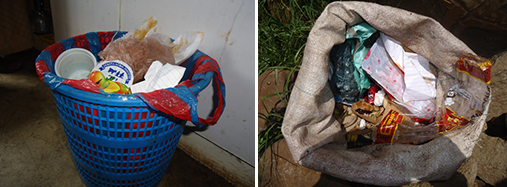7.5.1 Types of storage containers
According to the Solid Waste Management Proclamation (FDRE, 2007), solid wastes should be stored indoors in a closed container that is animal-proof and insect-proof. The containers should also be washable and strong enough to withstand normal day-to-day treatment. The container should be emptied every day into an outdoor storage container or directly into a disposal pit.
However, a recent situation assessment of waste management in 28 Ethiopian cities and towns indicated that 88% of the households use sacks to collect solid waste in their household (Addis Continental Institute of Public Health, 2015). So clearly, the majority of households store their solid waste in a container that does not meet the standard (Figure 7.4).

Where waste is collected for disposal, householders have to empty their waste containers into larger communal containers. These containers should also be fitted with lids to keep insects, other animals and rainfall out. An ideal container is shown in Figure 7.5, but open containers known as skips are often used (Figure 7.6).


7.5 Handling and on-site storage of solid wastes
